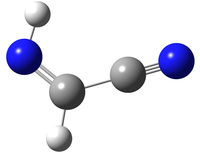|
The Z-isomer of C-cyanomethanimine is
lower in energy than the E-isomer.
Nevertheless, thus far only the latter has been
detected in space. The experimental data were
taken from
(1) S. Takano, M. Sugie, K. Sugawara, H. Takeo,
C. Matsumura, A. Masuda, and K. Kuchitsu,
1990, J. Mol. Spectrosc., 141, 13.
They derived the Z-isomer to be lower in
energy by 310 (70) K as suggested by
the context. (They wrote that it were higher in
energy.)
Additional data with extensive 14N
hyperfine splitting were obtained in the
context of
(2) D. P. Zaleski, N. A. Seifert, A. L. Steber,
M. T. Muckle, R. A. Loomis, J. F. Corby, O. Martinez,
Jr., K. N. Crabtree, P. R. Jewell, J. M. Hollis,
F. J. Lovas, D. Vasquez, J. Nyiramahirwe, N. Sciortino,
K. Johnson, M. C. McCarthy, A. J. Remijan,
and B. H. Pate,
2013, Astrophys. J., 765, Art. No. L10.
With respect to the first entry from Feb. 2014,
additional millimeter and submillimeter data were
included in the fit. They were reported by
(3) M. Melosso, A. Melli, C. Puzzarini, C. Codella, L. Spada,
L. Dore, C. Degli Esposti, B. Lefloch, R. Bachiller, C. Ceccarelli,
J. Cernicharo, and V. Barone,
2018, Astron. Astrophys., 609, Art. No. A121.
Quantum-chemical calculations by
(4) C. Puzzarini,
2015, J. Phys. Chem. A, 119, 11614
suggest the energy difference may be about half the
value determined in (1). The barrier between the two
supports the idea of two different isomers rather than
two conformers, even if formally no bond needs to be
broken.
D. P. Zaleski is thanked for the unpublished details
of their fit. That fit considered only a subset
of the data in (1), so the spectroscopic parameters
obtained here are different from those in (2).
Moreover, the hyperfine treatments is somewhat
different, as it was in the first version.
The mechanical parameters are the same as in (3),
and the values are very similar.
Predictions should be viewed with caution once
the predicted uncertainties exceed 0.3 MHz.
The 14N hyperfine splitting was at least partially
resolved in astronomical observations. Therefore, a separate
hyperfine calculation is provided up to J" = 18,
Ka" = 6, and up to 260 GHz
along with appropriate
partition function values.
Isomerization in the gas phase between E- and
Z-isomer can only take place at very high temperatures.
Therefore, the molecules are treated as two independent ones.
The a-dipole moment component was determined in (1).
The value of the b component was taken from a quantum
chemical calculation in (4).
|
